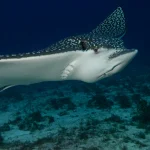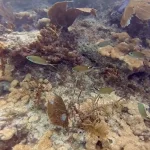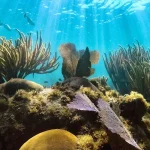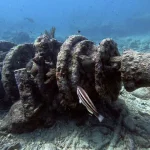Table of Contents
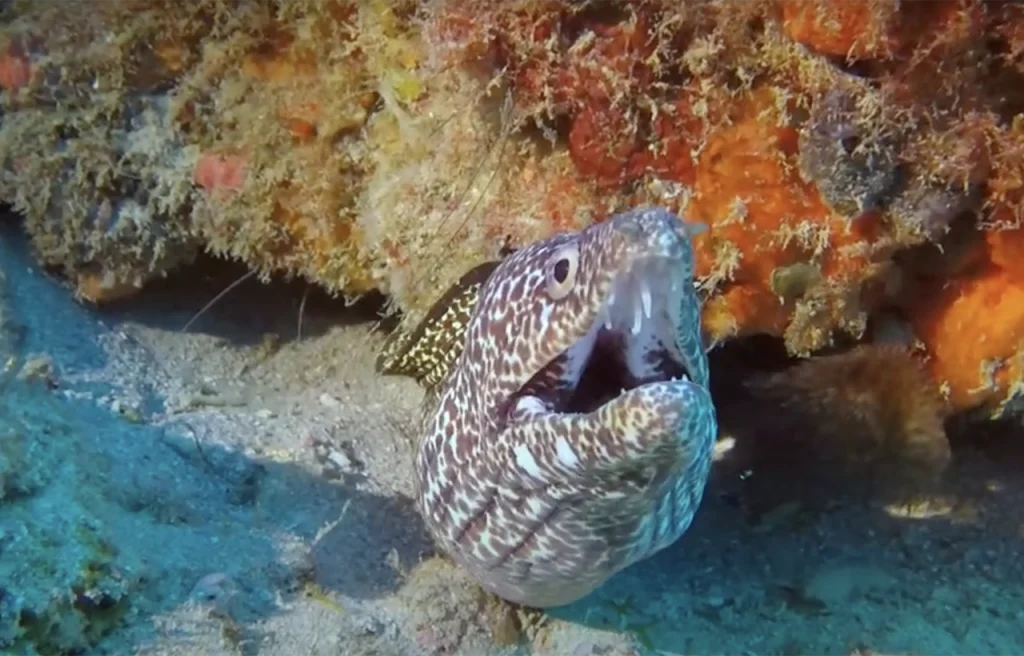
Bluffs Reef is a vibrant underwater habitat that offers divers a chance to see an impressive array of marine life, from majestic sea turtles to colorful fish and formidable sharks.
Article at a Glance
- Diving Depths: Bluffs Reef features depths ranging from 60 to 70 feet, with the bottom reaching up to 80 feet, making it accessible for both beginners and advanced divers.
- Marine Biodiversity: The reef is home to a rich variety of marine life, including Goliath groupers, sea turtles, reef sharks, and numerous species of tropical fish.
- Visibility Conditions: Divers can typically expect visibility between 20 to 40 feet, which can vary based on seasonal changes and weather conditions.
- Drift Diving Experience: The site is known for its drift diving opportunities, allowing divers to glide along the reef with minimal effort while observing the vibrant underwater ecosystem.
- Best Diving Seasons: The ideal times to dive are in spring and summer for active marine life, while fall is great for Goliath groupers and winter offers opportunities to see sharks.
- Suitability for All Levels: Bluffs Reef is suitable for both novice divers (with proper training) and experienced divers, providing challenges and excitement for all skill levels.
- Local Dive Operations: Several local dive shops offer guided dives, equipment rentals, and support for divers looking to explore this beautiful reef.
Bluffs Reef Jupiter
- Depth: The reef features depths ranging from 65 to 70 feet, making it accessible for both novice and experienced divers.
- Topography: Bluffs Reef is characterized by a series of cul-de-sacs along a high ledge, often described as “little aquariums” filled with colorful corals and sponges9.This structure provides excellent visibility and diverse habitats for marine life.
Marine Life:
- Common Sightings: Divers can expect to see a variety of species, including:
- Turtles: Loggerhead, Hawksbill, and Green turtles are frequently spotted either resting or foraging on the reef.
- Fish: The reef is home to large schools of tropical fish, as well as resident species such as Goliath groupers and moray eels.
- Sharks: Reef sharks are often seen swimming around the ledge, adding an exciting element to the dive experience.
Diving Experience
Accessibility:
- Bluffs Reef is accessible through several local dive shops in Jupiter, such as Jupiter Dive Center and Jupiter Scuba Diving, both of which offer guided dives to this site.
Diving Conditions:
- The reef is known for its consistent visibility and relatively easy navigation, making it a favored spot for divers looking to explore its rich marine ecosystem without extreme challenges.
Popular Dive Sites Nearby:
- Other notable dive sites in the area include Tunnels and Captain Mike’s, which also feature impressive marine life encounters and unique underwater landscapes.
What Marine Life Can I Expect To See?
Sea Turtles
- Loggerhead Turtles: Frequently spotted resting or foraging on the reef, these turtles are known for their large heads and strong jaws.
- Green Turtles: Often seen swimming around the ledge, they are recognized by their olive-brown shells.
- Hawksbill Turtles: These turtles, with their distinctive patterned shells, can also be found napping under ledges or searching for food.
Fish Species
- Goliath Groupers: These massive fish are often seen around the reef, sometimes in large aggregations during spawning seasons.
- Moray Eels: Green morays and spotted morays are common residents, often found in crevices and ledges.
- Butterflyfish: Various species, including four-eye and spotfin butterflyfish, add vibrant colors to the reef.
- Angelfish: Blue, Queen, Gray, and Rock Beauty angelfish are prevalent, often swimming in pairs throughout the reef.
Sharks
- Reef Sharks: Divers frequently encounter reef sharks cruising along the ledge.
- Nurse Sharks: These are often seen resting under ledges or among coral formations.
Other Marine Life
- Schools of Tropical Fish: Large schools of small fish, including scad and grunts, create a dynamic underwater scene.
- Invertebrates: Various species of sponges and corals contribute to the biodiversity of the reef ecosystem.
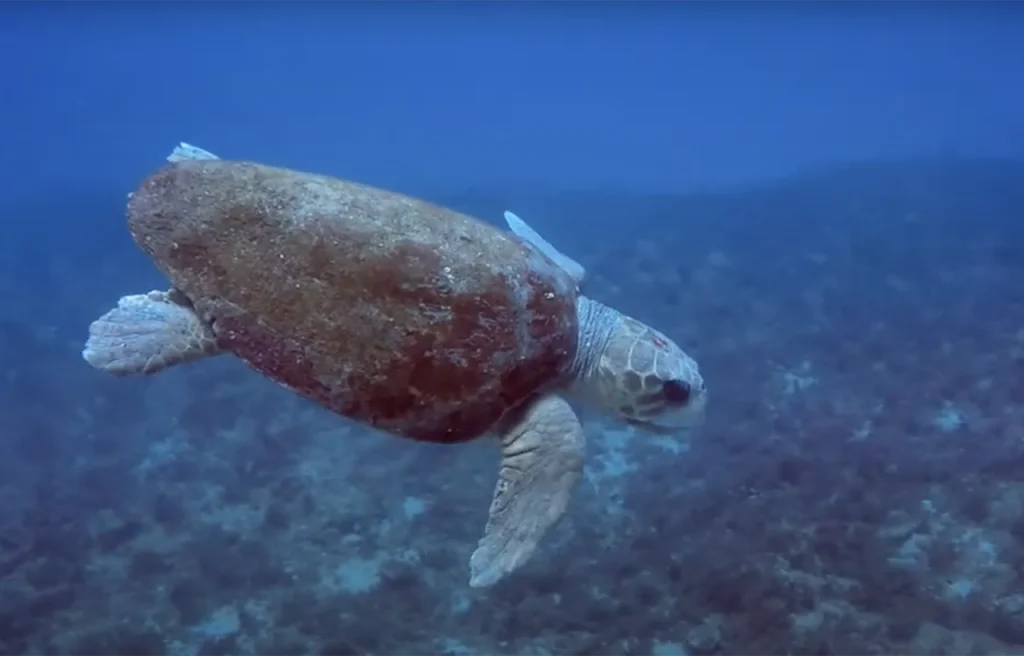
What Do Divers Say About This Site?
Positive Experiences
Diverse Marine Life
- Many divers highlight the abundance of marine life, including encounters with Goliath groupers, moray eels, and various species of turtles. One diver noted seeing sharks and hearing groupers “barking,” which adds excitement to the dive experience.
Scenic Underwater Environment
- The reef’s unique topography, described as a series of cul-de-sacs and vibrant coral formations, is frequently praised. Divers appreciate the colorful underwater scenery, which features large schools of tropical fish that create a mesmerizing atmosphere.
Professional Dive Operations
- Divers commend the dive operators for their professionalism and safety measures. Reviews indicate that crews are attentive and provide thorough briefings, making divers feel secure and well-informed during their dives.
Enjoyable Drift Dives
- The current at Bluffs Reef can be strong, but many divers find this exhilarating. They describe the experience as feeling like “Superman” while drifting along the reef, which adds to the thrill of the dive.
Amenities and Comfort
- Several reviews mention the comfort of the dive boats and the amenities provided, such as snacks and drinks during surface intervals. This attention to detail enhances the overall diving experience.
Key Information
| Category | Details |
|---|---|
| Location | Bluffs Reef, Jupiter, Florida |
| Depth Range | 60 to 70 feet (top of the ledge); up to 80 feet (bottom) |
| Visibility | 20 to 40 feet (varies by season and conditions) |
| Marine Life | Goliath groupers, sea turtles, reef sharks, moray eels, tropical fish |
| Dive Type | Drift diving |
| Suitable For | Beginners (with proper training) and advanced divers |
| Best Time to Dive | Spring and summer for marine life; fall for Goliath groupers; winter for sharks |
| Nearby Dive Sites | Captain Mike’s, Area 51, Jupiter Wreck Trek |
| Dive Operations | Local dive shops provide guided dives and equipment rentals |
| Special Considerations | Strong currents can occur; good buoyancy control recommended |
Highlights of Diving This Site?
Unique Underwater Topography
- Bluffs Reef features a series of cul-de-sacs along a high ledge, often described as “little aquariums.” This structure creates various habitats that are visually captivating and rich in biodiversity.
Abundant Marine Life
- Divers can expect to see a wide variety of marine species, including:
- Goliath Groupers: These large fish are often seen near the ledge, sometimes accompanied by smaller fish like Glassy sweepers.
- Turtles: Loggerhead, Hawksbill, and Green turtles are common, frequently found resting or foraging around the reef.
- Moray Eels: Green morays are prevalent, often spotted in crevices along the reef.
Thrilling Encounters
- Divers frequently report sightings of reef sharks cruising along the ledge and Southern stingrays resting in the sand. The presence of large schools of fish, such as Atlantic spadefish and various jacks, adds to the excitement of each dive.
Ideal Depth for Divers
- The reef is situated at a depth of approximately 65 to 70 feet, making it suitable for both novice and experienced divers. The relatively shallow depth allows for extended dive times while still providing opportunities to explore deeper areas.
Excellent Visibility
- Divers often enjoy good visibility conditions, which enhance the overall experience by allowing for clear views of the vibrant coral formations and marine life.
Drift Diving Experience
- The current at Bluffs Reef can provide a thrilling drift diving experience, allowing divers to glide effortlessly along the reef while observing the diverse ecosystem without much effort.
My Favorite Dive Computers
I have compared the 3 top diving computers for each category to help making the right choice easier:
Iconic Spots At This Site
The Main Ledge
- Description: This is the primary feature of Bluffs Reef, characterized by a series of cul-de-sacs and vibrant coral formations. The ledge sits at a depth of approximately 65 to 70 feet, making it accessible for divers of all skill levels.
- Marine Life: Divers can expect to see Goliath groupers, moray eels, and various species of turtles (Loggerhead, Hawksbill, and Green). The ledge is also frequented by schools of tropical fish, creating a colorful underwater spectacle.
Area 51
- Description: Known for its shark activity, this site features a high ledge dive where divers often encounter multiple reef sharks shortly after descending.
- Marine Life: In addition to sharks, divers may spot large schools of fish and vibrant corals, making it a visually stunning location.
Captain Mike’s
- Description: This site is celebrated for its dramatic underwater landscape, with a high ledge averaging between 15 and 20 feet in height from the sand. It offers a thrilling drift dive experience as currents carry divers along the reef.
- Marine Life: Divers can encounter curious reef sharks, Spotted Eagle rays, and during certain seasons, Lemon sharks. The resident Goliath grouper known as “Tug” is a highlight here.
Spadefish Point
- Description: This section of the reef is known for its lively atmosphere, where divers are often surrounded by large schools of spadefish.
- Marine Life: Expect to see cruising Black Tip and Caribbean Reef sharks, along with playful sea turtles and moray eels. This area is particularly noted for its dynamic marine interactions.
Scarface
- Description: Named after its alignment with the Jupiter Lighthouse, this dive site features a main ledge that varies in depth from 61 to 64 feet.
- Marine Life: The site offers a diverse array of marine life including reef sharks, eels, and Goliath groupers. It’s also popular among divers looking for lobsters or hunting fish.
Environmental Conservation Efforts at Bluffs Reef
Sawfish Bay Marine Restoration Project
- This multi-phase initiative aims to restore marine habitats by installing a living shoreline, promoting the growth of seagrass and oysters, and enhancing water quality (1). The project involves the installation of artificial reef modules and mangrove plantings along approximately 7,000 linear feet of shoreline. The restoration aims to contribute to the recovery of threatened species and improve the overall health of the marine ecosystem.
Marine Protected Areas (MPAs)
- The establishment of Marine Protected Areas in Florida aims to safeguard critical habitats and species from overfishing and habitat degradation. These areas help maintain biodiversity by restricting activities that can harm marine life, such as fishing and anchoring on coral reefs (2)(3).
Coral Reef Conservation Initiatives
- Various state and federal agencies are involved in monitoring coral health, conducting outreach programs, and enforcing regulations to protect Florida’s coral reefs. Efforts include reducing land-based pollution, installing mooring buoys to prevent anchor damage, and actively restoring coral populations through propagation programs (3)(4).
Community Engagement and Education
- Conservation efforts also focus on educating residents and visitors about responsible recreational activities that minimize environmental impact. This includes promoting sustainable diving practices and awareness about the importance of protecting marine ecosystems (3).
Collaborative Restoration Projects
- Partnerships between local governments, conservation organizations, and research institutions are crucial for effective marine habitat restoration. These collaborations aim to implement best practices for habitat recovery and monitor ecological changes over time (1).
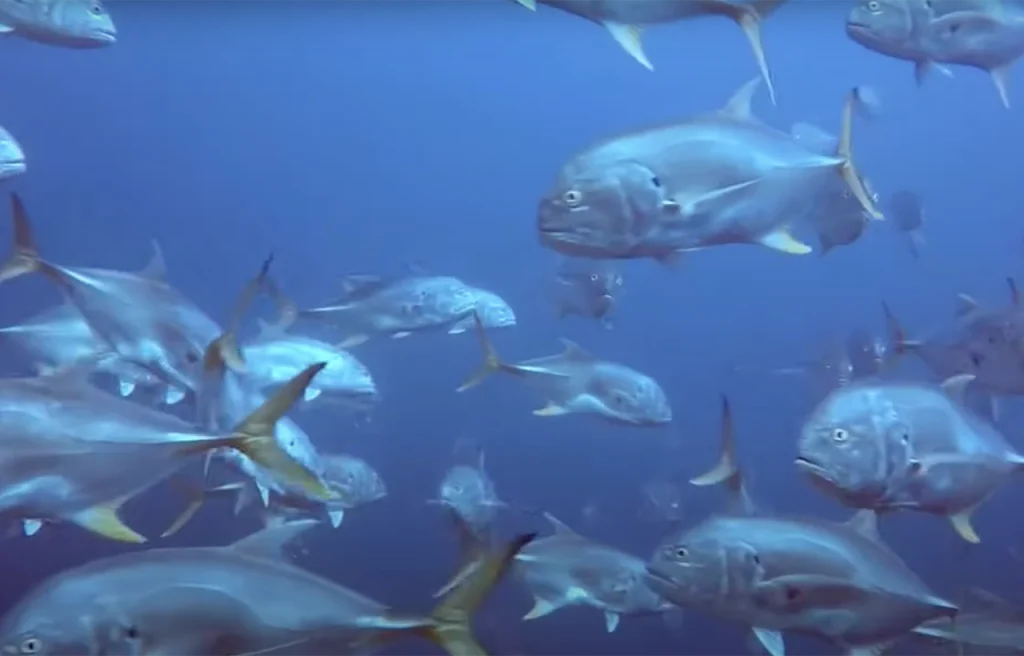
Maximizing Your Diving Experience at Bluffs Reef
Plan Your Dive Times
- Best Conditions: Aim to dive during optimal conditions, typically in the morning when visibility is often better and currents are milder. Check local dive shop schedules for the best times to go.
Go Slow
- Drift Diving: The currents can be strong, so take your time and avoid rushing through the dive. Moving slowly allows you to fully appreciate the vibrant marine life and unique features of the reef, such as the colorful corals and sponges.
Explore Iconic Spots
- Key Locations: Don’t miss iconic areas like Area 51 and Captain Mike’s, where you can encounter large schools of fish, Goliath groupers, and even curious reef sharks. Each spot offers a different experience with diverse marine life.
Look for Specific Marine Life
- Target Species: Keep an eye out for specific species such as Loggerhead turtles, Green morays, and Southern stingrays. The resident Goliath grouper is often found under ledges, making it a highlight for many divers.
Use Proper Gear
- Equipment Check: Ensure your diving gear is well-maintained and suited for drift diving. A wetsuit may be necessary due to cooler water temperatures, especially at depth.
Stay Aware of Your Surroundings
- Marine Life Interactions: Be patient and observant; many marine animals may appear if you remain still. Divers often report thrilling encounters with sharks and other large fish when they take their time.
Capturing Memories at Bluffs Reef: Photography Tips
Use the Right Equipment
- Wide-Angle Lenses: Bring a fisheye or rectilinear lens to capture the expansive underwater scenery and marine life. A fisheye lens is great for close encounters with larger subjects like sharks and turtles, while a rectilinear lens helps avoid distortion when shooting at a distance.
- Strobes: Utilize strobes to illuminate your subjects and reduce backscatter. Position them wide and high to enhance color vibrancy and minimize shadows (6).
Get Close to Your Subject
- Proximity Matters: The closer you are to your subject, the more detail you’ll capture. This is especially important in underwater photography where water can distort colors and details at a distance36. Aim to fill the frame with your subject for maximum impact.
Shoot Upward
- Composition Technique: When photographing reefscapes, shoot from below and angle your camera upward. This technique captures the lighter water color above, creating a more pleasing background with vibrant blues or greens.
Stay Calm and Patient
- Marine Life Interactions: Sharks and other marine creatures are often curious. Remain calm and still; let them approach you instead of chasing them. This increases your chances of capturing great shots without startling them.
Perfect Your Buoyancy Control
- Stability is Key: Good buoyancy control is crucial for clear images. Practice maintaining steady buoyancy before bringing your camera underwater to avoid unnecessary movement that can blur your photos.
Plan Your Shots
- Pre-Dive Preparation: Think about the types of shots you want to capture before diving. Consider including divers in your shots for scale or context, but ensure they do not touch or disturb the reef.
Adjust Lighting Settings
- Natural Light vs. Strobes: Depending on the depth and light conditions, you may need to adjust your camera settings accordingly. Use strobes to brighten foreground subjects while managing ambient light for background color balance (5)(6).
Frequently Asked Questions
When is the best time to dive at Bluffs Reef in Jupiter?
Spring (March to May)
Marine Life: This season is excellent for spotting sea turtles, including Loggerhead and Hawksbill turtles, as they become more active during their nesting season.
Conditions: Water temperatures begin to warm up, making dives more comfortable.
Summer (June to August)
Marine Life: Summer is prime time for seeing a variety of marine species, including lobsters and numerous tropical fish. The likelihood of encountering sea turtles remains high.
Conditions: Visibility is generally good, and the water temperature is warm, ideal for extended dives.
Fall (September to November)
Marine Life: This period is known for sightings of Goliath groupers, particularly during their spawning season in late summer and early fall.
Conditions: The water remains warm, but visibility can vary due to seasonal weather changes.
Winter (December to February)
Marine Life: Winter offers opportunities to see various species of sharks, including Lemon sharks, which frequent the area during this time.
Conditions: Water temperatures drop slightly, but diving remains popular due to good visibility and the chance to see larger marine life.
What is the visibility like while diving at Bluffs Reef in Jupiter?
Visibility while diving at Bluffs Reef in Jupiter, Florida, can vary significantly based on conditions and time of year.
Visibility Conditions
General Visibility Range
Divers can generally expect visibility to range from 20 to 40 feet, with conditions often being better in the summer months when water clarity improves due to warmer temperatures and calmer seas.
Seasonal Variations
Spring and Summer: Visibility tends to be at its best during these seasons, often exceeding 40 feet on good days. This is when marine life is most active, making it a popular time for divers.
Fall and Winter: Visibility can decrease, sometimes dropping to around 20 feet or less, particularly during windy weather or after storms.
Recent Reports
Recent dive reports indicate that visibility can fluctuate; for example, one diver noted visibility around 30 feet during a recent dive at Bluffs Reef, with varying conditions observed throughout the day.
Factors Affecting Visibility
Weather conditions, such as wind and rain, can impact visibility. Additionally, currents can stir up sediments, temporarily reducing clarity.
How deep are the dives at Bluffs Reef in Jupiter?
Diving at Bluffs Reef in Jupiter, Florida, typically involves depths that range from 60 to 70 feet on the top of the ledge, with the bottom reaching depths of approximately 75 to 80 feet. This depth range makes it accessible for both novice and experienced divers, allowing for enjoyable exploration of the vibrant marine life and unique underwater topography.
Depth Summary:
Top of the Ledge: 60 to 70 feet
Bottom of the Ledge: 75 to 80 feet
Is Bluffs Reef in Jupiter suitable for beginners?
Bluffs Reef in Jupiter, Florida, is considered suitable for beginner divers, primarily due to its accessible depths and the variety of marine life present.
Suitability for Beginners
Depth Range
The dives at Bluffs Reef typically range from 60 to 70 feet at the top of the ledge, which is manageable for beginners who have completed proper training and certification. This depth allows for enjoyable exploration without being excessively deep, making it less intimidating for new divers.
Rich Marine Life
The reef is known for its vibrant marine life, including Goliath groupe, sea turtles, and various tropical fish. This abundance of wildlife can enhance the diving experience and provide engaging encounters for novice divers.
Drift Diving Experience
Bluffs Reef offers drift diving, which can be easier for beginners as it allows divers to float along with the current rather than swimming against it. This method reduces physical exertion and lets divers focus on enjoying the underwater scenery.
Guidance and Support
Local dive operators typically provide experienced guides who can assist beginners throughout the dive, ensuring safety and helping them navigate the reef effectively. Many dive shops emphasize a supportive environment for novice divers.
Conditions
While visibility can vary, it often ranges from 20 to 40 feet, which is generally acceptable for beginner diving. Good visibility enhances safety and allows new divers to appreciate the underwater environment more fully.
Is Bluffs Reef in Jupiter suitable for advanced divers?
Bluffs Reef in Jupiter, Florida, is indeed suitable for advanced divers, offering a range of exciting features and experiences that cater to their skills.
Suitability for Advanced Divers
Depth and Topography
The diving depths at Bluffs Reef typically range from 60 to 70 feet, with the bottom reaching up to 80 feet. This depth allows advanced divers to explore the intricate underwater topography, including ledges and cul-de-sacs filled with vibrant marine life.
Rich Marine Life
Advanced divers can enjoy encounters with larger marine species, including Goliath groupers, various types of sharks, and multiple species of turtles. The diversity of marine life provides ample opportunities for photography and observation.
Drift Diving Experience
Bluffs Reef is known for its drift diving conditions, which can be exhilarating for experienced divers. The currents can vary in strength, allowing advanced divers to navigate the reef while enjoying the thrill of drifting along the underwater landscape.
Challenging Conditions
While the site is accessible to beginners, advanced divers will appreciate the opportunity to dive in varying conditions, including stronger currents that may require more skill in buoyancy control and navigation. This aspect can enhance the challenge and excitement of the dive.
Variety of Dive Sites Nearby
Advanced divers can also explore nearby sites like Captain Mike’s, Area 51, and the Jupiter Wreck Trek, which offer deeper profiles and unique underwater features. These sites often attract larger marine life and provide different diving experiences.
Opportunities for Specialty Diving
Advanced divers may engage in specialty dives such as night diving or wreck diving in the area, further enhancing their experience and skill set.
Jupiter Dive Sites
- Area 51
- Area 29
- Tunnels
- Loggerhead Reef
- Bluffs Reef
- Bonnies
- Captain Kurls
- Spadefish Point
- Coral Cove Park
- Captain Mike’s
- Julies
- Emerald Charters Shark Dive
- Jupiter Wreck Trek
- Donut
- Scarface Reef Andrew “Red” Harris No Shoes Reef
- Jupiter Inlet
- Step Reef
- Sawfish Bay
- Marine Restoration Reef
- North County Reef
- Lighthouse
- Finz Den
- High Ledge
- Leigh’s Ledge
- Monkey’s Ledge
- Gary’s


